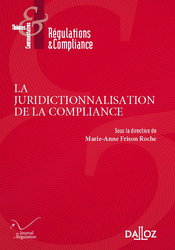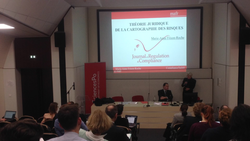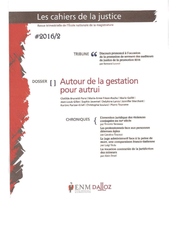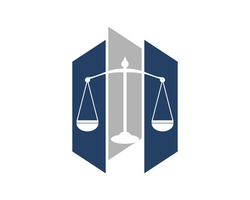Feb. 2, 2023
Thesaurus : Doctrine

► Full Reference: O. Douvreleur, "Compliance et juge du droit" ("Compliance and Judge ruling only on points of Law"), in M.-A. Frison-Roche (ed.), La juridictionnalisation de la Compliance, coll. "Régulations & Compliance", Journal of Regulation & Compliance (JoRC) and Dalloz, 2023, p. 465-471.
____
📕read a general presentation of the book, La juridictionnalisation de la Compliance, in which this article is published
____
► Summary of the article (done by the Journal of Regulation & Compliance): Compliance maintains with the judge complex relations, and even more with the judge ruling only on points of Law (in France, the Court de Cassation in the judicial order, the one who, in principle, does not know the facts that he leaves to the sovereign appreciation of the judges ruling on the substance of the disputes. At first glance, compliance is a technique internalised in companies and the place occupied by negotiated justice techniques leave little room for intervention by the judge ruling only on points of Law
However, his role is intended to develop, in particular with regard to the duty of vigilance or in the articulation between the different branches of Law when compliance meets Labor Law, or even in the adjustment between American Law and the other legal systems, especially French legal system. The way in which the principle of Proportionality will take place in Compliance Law is also a major issue for the judge ruling only on points of Law.
________
Nov. 28, 2019
Conferences

Reference : Frison-Roche, M.-A., General presentation of the cycle of conferences on Les outils de la Compliance (Compliance Tools) and "Théorie générale de la cartographie des risques" (Legal Theory of Risk Mapping), conference made in French, in Département d'Economie de Sciences Po & Journal of Regulation & Compliance (JoRC), La cartographie des risques, outil de la Compliance (Risk Mapping, as Compliance Tool), November 28th, 2019, Sciences Po, Paris.
- Read the General Presentation of the serie Régulations & Compliance in which the book will be published
Summary of the conference
Risk mapping is both central to the obligations or practices of companies and little apprehended by the legal systems. It is not expressly referred to by the French legal system, except for the special national laws known as "Sapin 2" and "Vigilance". But if we are out of this field, because there is only a description and not a legal definition, even less a legal notion, we do not know what legal regime to apply to the action of mapping risks. It is therefore useful, indeed compelling, to define the legal concept of risk mapping. Starting from what is still the safest ground, namely these two special laws, to go towards less secure legal grounds, such as the doctrine of the authorities or the commitments of the companies, even the ISO certifications obtained in this matter. Through a few judicial decisions and legal reasoning, a legal notion of the action of mapping risks emerges.
It is advisable to proceed in 5 steps (the working document follows another approach).
The first, based directly on the two available laws, apprehends the action of mapping when it comes into execution of a special legal obligation. The decision rendered in 2019 by the French Commission des sanctions of the Agence Française Anticorruption (French Corruption Agency's Sanctions Commission) draws probate games as to the demonstration of the execution of the obligation and the probationary system can be extended. In the same way the decision of the French Conseil constitutionnel (Constitutional Council) in 2017 on the "Vigilance Act" shows that a mechanism referred to as a "modality" is legitimate with regard to the goal, which is, concerning this tool, the establishment of a responsibility for others. It is therefore the concern for the situation of others that can be targeted by the Law thanks to Compliance Tool, especially Risk Mapping.
The second theme aims to map risks as a fact of good management for a company, while the enterprise is not constrained by a legal obligation. This fact is a paradox because the Regulatory Authority and the Judge may, where the conduct that was to be prevented occurs, for example a market abuse or an anti-competitive behavior, either qualify as an aggravating circumstance or as an attenuating circumstance. Consideration of the theory of incentives should lead to the adoption of the American solution, that is to say the qualification of an effective cartography as a mitigating fact. European case law is not yet fixed, especially in terms of Competition Law's compliance.
The third theme is the mapping action carried out by an entity which, in doing so, exercises power over a third party. Because cartography is as much an obligation as a power, possibly on a third party. The Conseil d'Etat (French Council of State) in 2017 qualified risk mapping as an act of grievance, but doing so legitimately, since it was to prevent forest fires efficiently. This solution based on the teleology attached to Compliance Law can be transposed to other areas.
Going further, one may consider transforming this action from de facto status to legal status on the part of the company, if it thus identifies risks for third parties. It would thus give third-party creditors the right to be in a position to measure the risks that weigh on them. Risk mapping would thus be part of a broader unilateral commitment by powerful companies, recognizing the existence of risks for third parties to enable them to know their nature and extent. If this responsibility Ex Ante (characteristic of Compliance Law) is fulfilled, then the Ex Post liability of the company could no longer be retained. This is the ongoing issue of the Johnson & Johnson trial (2019 American judgment), in terms of medical compliance. Because if one can argue that there exists through this kind of risk mapping that the posology a "subjective right to be worried about the risks related to the taking of the drug", the patient remains free in the use of it. The question of whether third-party education is included in the mapping, since the alert is already included in it, is an open question. For now, the answer is negative.
Indeed and in a fifth time, appears the liberal definition of Compliance Law through the apprehension that the Law must make of the cartography of the risks. Beyond the rational act that any person has to control their risks for their own interest, by preventing the damaging effects of that from the crystallization of risk has in fact proved, it is a question of preserving an external interest for the preservation of which the Law must intervene because the subject of law, in particular the company will be less likely to be concerned.
By the imprint of the law, risk mapping expresses the concern for an external interest, either of a system or of a third party. But this support in Ex Ante implies force (Sapin 2, Vigilance, financial market information obligation) or will (social responsibility, ethical commitment, adoption of non-financial standards) relates only to information, its constitution, its intelligibility and its hierarchy. Then it is the actors exposed to the risks, able to understand in Ex Ante the extent as far as they are concerned, either the entity itself, or the thirds, to choose to run them to no.
- Consult the two sets of slides as basis of the conference:
- Slides served as basis for the General Presentation of the cycle of conference on the Compliance Tools (in French)
- Slides served as basis for the specific contribution "Théorie générale de la cartographie des risques / Legal Theory of Risk Mapping" (in French).
______
Updated: Sept. 6, 2016 (Initial publication: June 15, 2016)
Publications

Référence complète : Frison-Roche, M.-A., Face au fait des maternités de substitution, que peut faire le juge ?, in Dossier "Autour de la gestation pour autrui", Les cahiers de la justice, Revue trimestrielle de l'École nationale de la magistrature, ENM/Dalloz, 2016.
La GPA, ou maternité de substitution, est une pratique qui conduit à s'interroger sur la normativité juridique à travers la relation entre le droit et le fait, que celui-ci soit technologique, sociétal, économique ou géographique.
Face aux litiges qui lui sont soumis, le juge français doit rendre une décision en application des règles de droit en vigueur, y compris européennes.
La question ici posée est de savoir si, au regard de ses pouvoirs et de son office, le juge peut et doit dégager des solutions techniques plus fines et s'il peut et doit répondre par principe.

April 5, 2015
Publications

Droit et Marché à première vue ne sont pas sur le même plan, l'un étant une construction, une invention humaine, l'autre étant des marchés. Mais depuis le XVIIIième en Europe, l'on a pareillement institué, donc inventé le "Marché".
Ces deux institutions ont un rapport dialectique, puisque c'est par le droit que le Marché a été construit. La puissance des institutions dépend de ceux qui les construisent mais surtout de la foi de ceux qui les contemplent. Or, si le Droit a construit le Marché, aujourd'hui la foi se tourne vers le Marché et la croyance d'une loi qui lui sera proche et naturelle le rend universel, transportant avec lui sa "petite loi" juridique qu'est le contrat et le juge qui y est inclus, l'arbitre.
Plus encore, parce tout cela n'est qu'affaires humaines et donc affaires de pouvoir, la place de l'Institution qui fût celle de la puissance, tirée de sa source, par exemple le Peuple Constituant, est en train de descendre en-dessous de ce qui est là, c'est-à-dire le fait. En effet, que peut-on contre un fait ? Seul Dieu, et donc une Assemblée parlementaire par exemple qu'il est aisé de destituer, peut prétendre lutter contre un fait. Or, le Marché est aujourd'hui présenté comme un fait, tandis que ce qui le gouvernent seraient des phénomènes naturels, comme l'attraction entre l'offre et la demande, le fait d'offre ce qui attire, le fait de demander ce que l'on désire. Dès lors, seul Dieu, souvent brandi avec grande violence, peut prétendre encore dire quelque chose contre cela.
Aujourd'hui, Droit et Marché sont face à face. Curieusement les juristes sont assez taisant, peut-être sidérés de la destitution du Droit. Mais c'est la question de la Loi première qui est en jeu. Dans l'esprit occidental, depuis la pensée grecque l'on a pensé le sujet et la personne comme étant première, c'est-à-dire posée sans condition. Si on pose comme loi première l'efficacité de la rencontre des offres et des demandes, le monde a changé. Un monde sans Personne, avec des êtres humains plus ou moins attrayant, plus ou moins demanding , le monde des puissances ayant remplacé le monde de la volonté égale de tous. La technique devient la préoccupation première. Le droit qui était "art pratique" et les lois faites pour l'homme, devient une technique et les juristes se devront alors d'être neutres.
Depuis quelques décennies, Droit et Marché sont donc face-à-face (I), mais le Marché semble en passe de dominer parce qu'il est en train de quitter le statut inférieur d'institution pour accéder à celui, universel, de fait (II). L'enjeu devient alors de mesurer les effets d'une telle évolution et de déterminer, si le Droit devait s'effacer, quelles normes viendrait le remplacer (III).
Updated: July 31, 2013 (Initial publication: Oct. 25, 2011)
Teachings : Les Grandes Questions du Droit, semestre d'automne 2011
